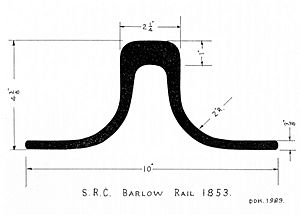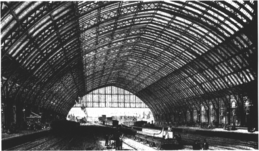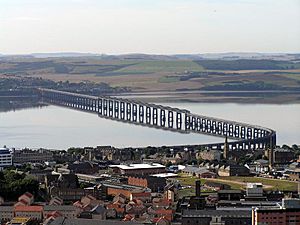William Henry Barlow facts for kids
Quick facts for kids
William Henry Barlow
FRS FRSE FICE MIMechE
|
|
|---|---|
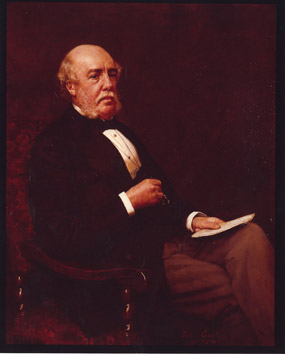
Barlow by John Collier, 1880
|
|
| Born | 10 May 1812 Woolwich, Kent, U.K.
|
| Died | 12 November 1902 (aged 90) Charlton, London, U.K.
|
| Occupation | Engineer |
| Parent(s) | Peter Barlow |
| Engineering career | |
| Discipline | Civil |
| Institutions |
|
| Projects | |
| Significant design | Barlow rail |
William Henry Barlow (1812–1902) was a very important English civil engineer in the 1800s. He is most famous for his work on railways. Barlow helped build many big projects. He was the engineer for the Midland Railway's train line into London. He also designed the amazing St Pancras train station in London.
Barlow also helped finish the Clifton Suspension Bridge with John Hawkshaw. This bridge was first started by Isambard Kingdom Brunel. After the terrible Tay Bridge disaster, Barlow helped figure out what went wrong. He then designed the new Tay Bridge. Barlow was also an inventor. He created a special type of rail for train tracks. He also studied how to use steel in buildings.
Contents
Who Was William Barlow?
William Barlow was born on May 10, 1812. His birthplace was Woolwich, Kent, which is now part of south-east London. His father was Peter Barlow, a professor of math and physics. Peter Barlow taught at the Royal Military Academy in Woolwich.
William had a private education. At 16, he started studying civil engineering with his father. After a year, he became an apprentice. He worked in the machinery department of the Royal Navy's Woolwich Dockyard. Later, he worked at the London Docks for Henry Robinson Palmer.
In May 1842, Barlow married Selina Crawford Caffin. They had four sons and two daughters. One of their sons, Crawford Barlow, also became a civil engineer. He worked with his father.
Barlow's Engineering Career
From 1832, Barlow worked for six years in Constantinople (now Istanbul, Turkey). He helped build a factory for making weapons. He also wrote a report for the Turkish government about lighthouses in the Bosphorus strait. For his work, he received an award called the Order of Nishan Iftikhar.
Working on Railways
Barlow came back to Britain in 1838. He became an assistant engineer for the Manchester and Birmingham Railway. In 1842, he joined the Midland Counties Railway. He was the main engineer for the section between Rugby and Derby. When this railway became part of the larger Midland Railway in 1844, he became its chief engineer.
Barlow became a member of the Institution of Civil Engineers in 1845. In 1850, he was chosen as a Fellow of the Royal Society.
While working on the Midland Railway, Barlow noticed something important. Replacing the wooden sleepers under the tracks cost more than replacing the rails themselves. This was because sleepers wore out faster. To save money, he invented his own rail design in 1849. His design, called the Barlow rail, had a wide base. It could be laid directly on the ground without sleepers. Only small metal bars were needed to keep the tracks the right distance apart. Many railways, especially the Great Western Railway, used his invention.
Joseph Paxton, who designed the famous Crystal Palace for the Great Exhibition of 1851, was a director of the Midland Railway. He asked Barlow to help with the calculations for the Crystal Palace's metal frame.
Building Famous Bridges

In 1857, Barlow started his own engineering company in London. The Midland Railway remained a big client. After Isambard Kingdom Brunel died in 1859, Barlow and John Hawkshaw were asked to finish the Clifton Suspension Bridge in Bristol. Construction had stopped in 1843 because there wasn't enough money.
Barlow and Hawkshaw used the metal chains from Brunel's earlier Hungerford Bridge in London. That bridge was taken down in 1860. They finished the Clifton Suspension Bridge in 1864. It had a stronger deck than Brunel had planned. Its main span was 702 feet (214 meters) long. This made it the longest bridge span in Britain at that time.
Designing St Pancras Station
Between 1862 and 1869, Barlow was the main engineer for the Midland Railway's new line into London. This included designing the huge St Pancras train station on Euston Road. The station was built on a slope and had to cross the Regent's Canal. So, the train platforms were built on a raised structure. This structure was supported by cast iron columns and beams.
Underneath the platforms, there was space to store beer from breweries. Barlow, with help from Rowland Mason Ordish, also designed the station's huge arched roof. This roof was made of cast iron and stretched 240 feet (73 meters) across the platforms without any middle supports. It was the widest roof of its kind in the world back then. It was a smart way to avoid needing more support structures below. The hotel in front of the station was designed by George Gilbert Scott.
Investigating the Tay Bridge Disaster
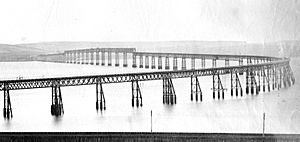
On December 28, 1879, a terrible event happened. The middle part of the North British Railway's bridge over the River Tay near Dundee collapsed. This happened during a heavy storm as a train was crossing. All 75 people on the train died in the Tay Bridge disaster.
Barlow was the newly elected President of the Institution of Civil Engineers. He was asked to be part of the official investigation into the disaster. He worked with Henry Cadogan Rothery and William Yolland. They wrote one of the final reports. They suggested that a group should study how wind affects bridges. Their report, from June 30, 1880, said that the bridge was "badly designed, badly built and badly maintained." The bridge, designed by Sir Thomas Bouch, had only opened the year before. The entire central section fell, leaving a gap of almost half a mile in the 2-mile (3.2 km) long bridge.
Sir Thomas Bouch's reputation was ruined, and he died in October 1880. Work on another bridge he had designed, the Forth Bridge, was stopped. Barlow, Sir John Fowler, and Thomas Elliot Harrison were asked to choose a new design. They chose the cantilevered design for the Forth Bridge, created by Fowler and Sir Benjamin Baker.
In 1881, Barlow was part of a group that studied how wind pressure affects railway structures. He then led the design of the new Tay Bridge (built from 1882 to 1887). His son, Crawford Barlow, was also an engineer on this project. The new bridge used large, strong piers to hold up two railway tracks. The old brick piers from the first bridge were kept. They now act as breakwaters for the new piers. You can still see them today, reminding people of the 1879 tragedy.
Other Contributions and Later Life
Barlow was one of the first engineers to experiment with using steel in civil engineering. He did research in the 1850s. He was also on a committee that made the first safety rules for using steel in railway structures in 1877.
Barlow also experimented with recording sound. In 1874, he gave a talk to the Royal Society. He showed his "recording instrument" which he called a Logograph.
Barlow was a member of many important groups. These included the Royal Society of Edinburgh, the Institution of Mechanical Engineers, and the Society of Arts. He was also a Vice President of the Royal Society in 1881. He was an honorary member of a French engineering society. He was also a Lieutenant-Colonel in the Railway Volunteer Staff Corps.
Barlow retired in 1896 because his health was failing. His son also retired with him. William Henry Barlow passed away on November 12, 1902. He was buried in Charlton Cemetery, next to his father's grave. His home in Greenwich has a blue plaque to remember him.


